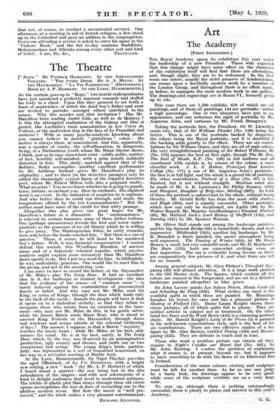Art
The Academy
[FIRST IMPRESSION.]
THE Royal Academy opens its exhibition this year under the leadership of a new President. Those who expected that this change might have some effect on the character of the exhibition itself will find that there are alterations, and, though slight, they are to be welcomed. In the first room one enters, usually the strict preserve of Academicians. one comes upon a decidedly modern work by a member of the London Group, and throughout there is no effort made, as before, to segregate the more modern work in one gallery. The drawings and engravings are in Room VI., formerly given up to oils.
This year there are 1,590 exhibits, 619 of which are oil paintings, and of these oil paintings 144 are portraits—rather a high percentage. One or two absentees have put in an appearance, and one welcomes the sight of portraits by Mr. Augustus John, and cartoons by Mr. Frank Brangwyn.
Taking the portraits first, the President, Sir W. Llewellyn sends two, that of Sir William Pleader (No. 138) being the better. This is one of the portraits backed by draperies, the others being the Royal portraits, and it is doubtful if the backing adds greatly to the effect. There arc six contri- butions by Sir William Orpen, and they are all of male sitters. His very straightforward painting of Sir Robert Williams, Bt. (No. 173) appears the best at first sight, though The Rt. Hon. The Earl of Meath, K.P. (No. 120) in full uniform and all smothered with medals is, by reason of the colour, a more cheerful work. J. L. S. Hatton, Principal, East London College (No. 177) is one of Mr. Augustus John's portraits : the face is in full light, and the whole is a grand bit of painting. His other contribution, Portrait of a Man (No. 67) is less finished, but is not without strength. Mention must also be made of Mr. A. K. Lawrence's Sir Philip Bassoon (334) and Margaret, Daughter of Brig.-Gen. Stirling (607). In both of these the portrait is subservient to the whole, without losing thereby. Mr. Gerald Kelly has done the same with Andrew and Hugh (805), and is equally successful. Other portraits, which now can only be mentioned, are Lydia (46) by Mr. Walter Russell, Mr. Maurice Greiffenhagen's Etonitui Portrait (93), Mr. Richard Jack's Lord Bishop of Sheffield (132), and Dorothy (841) by Mr. Spencer Watson.
Mr. Oliver Hall stands out among the landscape painters, and his big Spanish Bridge (86) is beautifully drawn, and most impressive.. Ribblesdak (585), another big landscape, by Mr. R. Brundrit is finely handled, the snowy atmosphere being well expressed. The Passing of Winter (492), by Mr. Owen Bowen, a small, but very colourful work, and Mr. D. Muirhead's The Ruin (155) both are somewhat striking even on first inspection. The sea is evidently losing favour, as there are comparatively few pictures of it, and what there are call for no remark.
Among general subjects Mr. Glyn Philpot's Threefold Epi- phany (50) will attract attention. It is a large work painted in the Old Master style. The figures, which contain all the colour, are massed in the foreground, and are set in a detailed landscape painted altogether in blue green.
Sir John Lavery paints Les Salons Prices, Monte Carlo (3) and Schooling the Pony (202). What strikes one most is the youthful spirit in which these are painted. Mr. Munnings forsakes his horses for once and has a pleasant picture of Skating at Platford (51). Dame Laura Knight shows three circus pictures, all of which quite fail to please. They arc neither artistic in subject nor in treatment. On the other hand her Susie and the Wash Basin (443) is a charming portrait study. Mr. Harold Knight's Lady at the Piano (2) is painted in his well-known conscientious style, and is the best of his six contributions. There are two effective studies of a lay figure by Mr. Alan Beeton, entitled Posing (450) and Decom- posing (455). They are delicate in touch and in tone.
Those who want a problem picture can obtain all they require in Night's Candles are Burnt Out (No. 421), .by Mr. John Keating. I confess the problem of explaining what it means is, at present, beyond me, but it appears to have something to do with the dawn of an Electrical Era in Ireland.
Consideration of the water colours, etching and sculpture must be left for another time. As far as one can judge by a hasty look, the drawings appear to be very good, while some of the sculpture exhibits are on a very large scale.
To sum up, although there is nothing outstandingly successful, there is plenty to please and interest in this year's Academy.
G. 'G.






















































 Previous page
Previous page